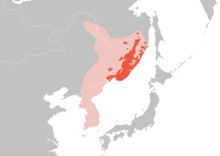
Back Амур къэплъан ADY Siberiese tier Afrikaans ببر سيبيري Arabic ببر سيبيرى ARZ Jaktol (Panthera tigris altaica) AVK Amur pələngi Azerbaijani Sibiarische Diga BAR Сибирски тигър Bulgarian সাইবেরিয়ার বাঘ Bengali/Bangla Sibirski tigar BS
| Siberian tiger | |
|---|---|

| |
| Siberian tiger at the Leipzig Zoological Garden | |
| Scientific classification | |
| Domain: | Eukaryota |
| Kingdom: | Animalia |
| Phylum: | Chordata |
| Class: | Mammalia |
| Order: | Carnivora |
| Suborder: | Feliformia |
| Family: | Felidae |
| Subfamily: | Pantherinae |
| Genus: | Panthera |
| Species: | P. tigris |
| Subspecies: | P. t. tigris |
| Population: | Siberian tiger |

| |
| Siberian tiger distribution
Modern-day range
Range in the late 1800s
| |
The Siberian tiger or Amur tiger is a population of the tiger subspecies Panthera tigris tigris native to the Russian Far East, Northeast China[1] and possibly North Korea.[2] It once ranged throughout the Korean Peninsula, but currently inhabits mainly the Sikhote-Alin mountain region in southwest Primorye Province in the Russian Far East. In 2005, there were 331–393 adult and subadult Siberian tigers in this region, with a breeding adult population of about 250 individuals. The population had been stable for more than a decade because of intensive conservation efforts, but partial surveys conducted after 2005 indicate that the Russian tiger population was declining.[3] An initial census held in 2015 indicated that the Siberian tiger population had increased to 480–540 individuals in the Russian Far East, including 100 cubs.[4][5] This was followed up by a more detailed census which revealed there was a total population of 562 wild Siberian tigers in Russia.[6] As of 2014, about 35 individuals were estimated to range in the international border area between Russia and China.[7]
The Siberian tiger is genetically close to the now-extinct Caspian tiger. Results of a phylogeographic study comparing mitochondrial DNA from Caspian tigers and living tiger populations indicate that the common ancestor of the Siberian and Caspian tigers colonized Central Asia from eastern China, via the Gansu−Silk Road corridor, and then subsequently traversed Siberia eastward to establish the Siberian tiger population in the Russian Far East.[8] The Caspian and Siberian tiger populations were the northernmost in mainland Asia.[9][10]
The Siberian tiger was also called "Amur tiger", "Manchurian tiger", "Korean tiger",[2] and "Ussurian tiger", depending on the region where individuals were observed.[9][11]
- ^ Cite error: The named reference
catsgwas invoked but never defined (see the help page). - ^ a b Rak, K. C.; Miquelle, D. G. & Pikunov, D. G. (1998). A survey of tigers and leopards and prey resources in the Paektusan area, North Korea, in winter 1998 (PDF) (Report). Archived from the original on 5 December 2020. Retrieved 16 June 2012.
- ^ Goodrich, J.; Lynam, A.; Miquelle, D.; Wibisono, H.; Kawanishi, K.; Pattanavibool, A.; Htun, S.; Tempa, T.; Karki, J.; Jhala, Y. & Karanth, U. (2015). "Panthera tigris". IUCN Red List of Threatened Species. 2015: e.T15955A50659951.
- ^ WWF Russia (2015). "Russia Announce Tiger Census Results!". tigers.panda.org. Worldwide Fund for Nature. Retrieved June 7, 2015.
- ^ Hance, J. (2015). "Happy tigers: Siberian population continues to grow". Mongabay.com. Retrieved 13 June 2015.
- ^ The Siberian Times reporter (2015). "Sex imbalance as endangered Siberian tigers show signs of recovery". The Siberian Times. Retrieved 18 December 2015.
- ^ Xiao, W.; Feng, L.; Mou, P.; Miquelle, D. G.; Hebblewhite, M.; Goldberg, J. F.; Robinson, H. S.; Zhao, X.; Zhou, B.; Wang, T. & Ge, J. (2016). "Estimating abundance and density of Amur tigers along the Sino–Russian border". Integrative Zoology. 11 (4): 322−332. doi:10.1111/1749-4877.12210. PMID 27136188.
- ^ Driscoll, C. A.; Yamaguchi, N.; Bar-Gal, G. K.; Roca, A. L.; Luo, S.; Macdonald, D. W. & O'Brien, S. J. (2009). "Mitochondrial Phylogeography Illuminates the Origin of the Extinct Caspian Tiger and Its Relationship to the Amur Tiger". PLOS ONE. 4 (1): e4125. Bibcode:2009PLoSO...4.4125D. doi:10.1371/journal.pone.0004125. PMC 2624500. PMID 19142238.
- ^ a b Mazák, V. (1981). "Panthera tigris" (PDF). Mammalian Species (152): 1–8. doi:10.2307/3504004. JSTOR 3504004.
- ^ Heptner, V. G. & Sludskij, A. A. (1992) [1972]. "Tiger". Mlekopitajuščie Sovetskogo Soiuza. Moskva: Vysšaia Škola [Mammals of the Soviet Union. Volume II, Part 2. Carnivora (Hyaenas and Cats)]. Washington DC: Smithsonian Institution and the National Science Foundation. pp. 95–202.
- ^ Loukashkin, A. S. (1938). "The Manchurian Tiger". The China Journal. 28 (3): 127–133.
© MMXXIII Rich X Search. We shall prevail. All rights reserved. Rich X Search